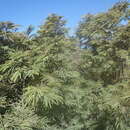Comprehensive Description
provided by North American Flora
Lysiloma thornberi Britton & Rose, sp. nov
A shrub or small tree; young twigs pilose, but glabrate in age. Leaves 10 to 15 cm. long; stipules 10 to 12 mm. long, ovate, thin, caducous; petiole and rachis pilose; petiole bearing a small, slightly elevated gland; pinnae 6 to 8 pairs; leaflets 20 to 35 pairs, linearoblong, 5-6 mm. long, obtuse, glabrous, the midrib nearly central; peduncles slender, 2 to 3 cm. long, pilose; flowers capitate, sessile, white; calyx 1.5 mm. long, densely pubescent; corolla somewhat longer than the calyx; stamen-sheath short; legume oblong, 10-17 cm. long, 12-20 mm. wdde, glabrous, glaucous, stipitate, apiculate, the base cuneate.
Rincon Mountains, Arizona. Type collected in 1926 by J. J. Thornber.
- bibliographic citation
- Nathaniel Lord Britton and Joseph Nelson Rose. 1928. (ROSALES); MIMOSACEAE. North American flora. vol 23(1). New York Botanical Garden, New York, NY
Comprehensive Description
provided by North American Flora
Lysiloma brevispicata (Rose) Britton & Rose
Lysiloma acapulcensis brevispicata Rose, Contr. U-. S. Nat. Herb. 1: 100. 1891.
A tree, 10-13 m. high, with a trunk up to 3 dm. in diameter, or larger, the twigs pilose. Stipules caducous; petioles pilose, bearing a large gland near the middle; pinnae 3-5 pairs; leaflets many pairs, linear, 4—5 mm. long, hairy on both sides; peduncles axillary, in clusters of 3-6, pilose, 3-4 cm. long; flowers pubescent, sessile, in dense spikes 12-20 m n. long; calyx about 2 mm. long; corolla about 3 mm. long; stamens 2-3 times as long as the corolla.
Type locality: Near Alamos, Sonora. Distribution: Known only from the type locality.
- bibliographic citation
- Nathaniel Lord Britton and Joseph Nelson Rose. 1928. (ROSALES); MIMOSACEAE. North American flora. vol 23(1). New York Botanical Garden, New York, NY
Physical Description
provided by USDA PLANTS text
Perennial, Trees, Woody throughout, Nodules present , Stems erect or ascending, Stems greater than 2 m tall, Stems solid, Stems or young twigs sparsely to densely hairy, Stems hairs pilose or spreading, Leaves alternate, Leaves petiolate, Extrafloral nectary glands on petiole, Stipules conspicuous, Stipules green, triangulate to lanceolate or foliaceous, Leaves compound, Leaves bipinnate, Leaf or leaflet margins entire, Leaflets opposite, Leaflets 10-many, Leaves hairy on one or both surfaces, Inflorescences globose heads, capitate or subcapitate, Inflorescence axillary, Bracts very small, absent or caducous, Bracteoles present, Flowers sessile or nearly so, Flowers actinomorphic or somewhat irregular, Calyx 5-lobed, Calyx glabrous, Petals united, valvate, Petals white, Stamens numerous, more than 10, Stamens monadelphous, united below, Stamens long exserted, Filaments glabrous, Style terete, Fruit a legume, Fruit stipitate, Fruit unilocular, Fruit freely dehiscent, Fruit elongate, straight, Fruit oblong or ellipsoidal, Frui t coriaceous or becoming woody, Fruit exserted from calyx, Fruit internally septate between the seeds, Fruit compressed between seeds, Fruit glabrous or glabrate, Fruit 11-many seeded, Seeds ovoid to rounded in outline, Seed surface smooth, Seeds olive, brown, or black.

